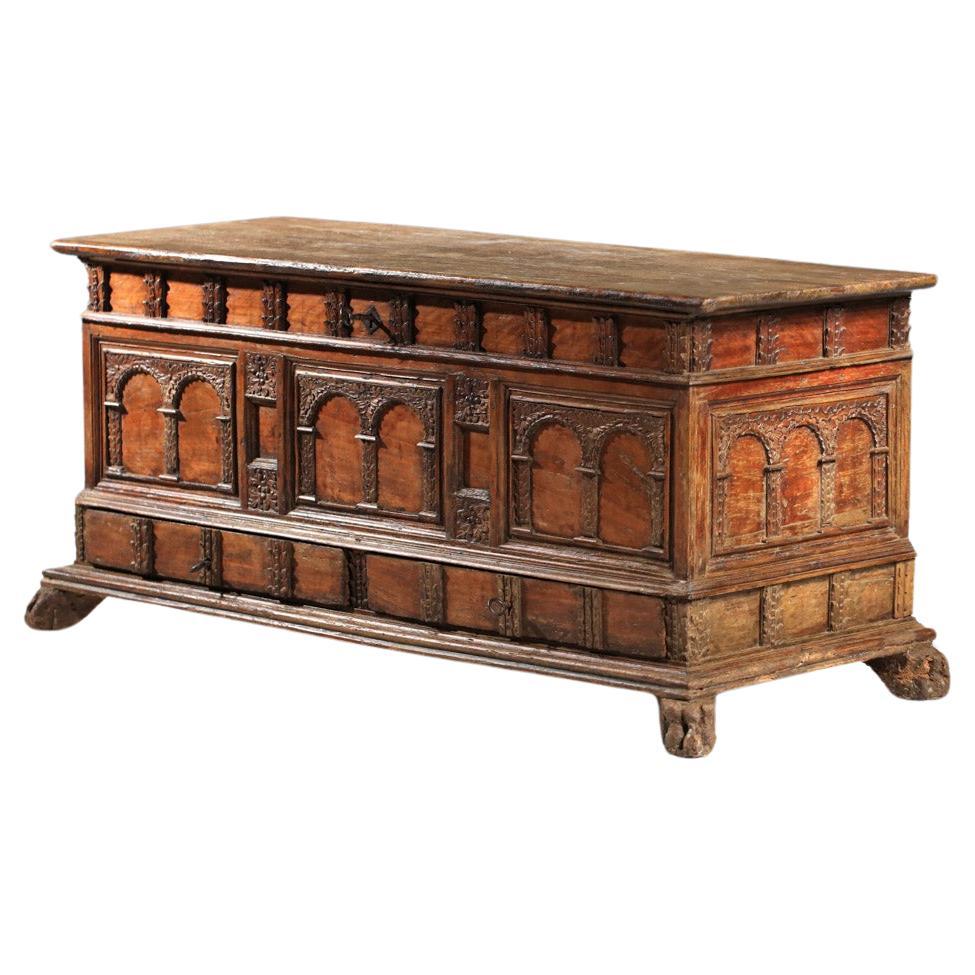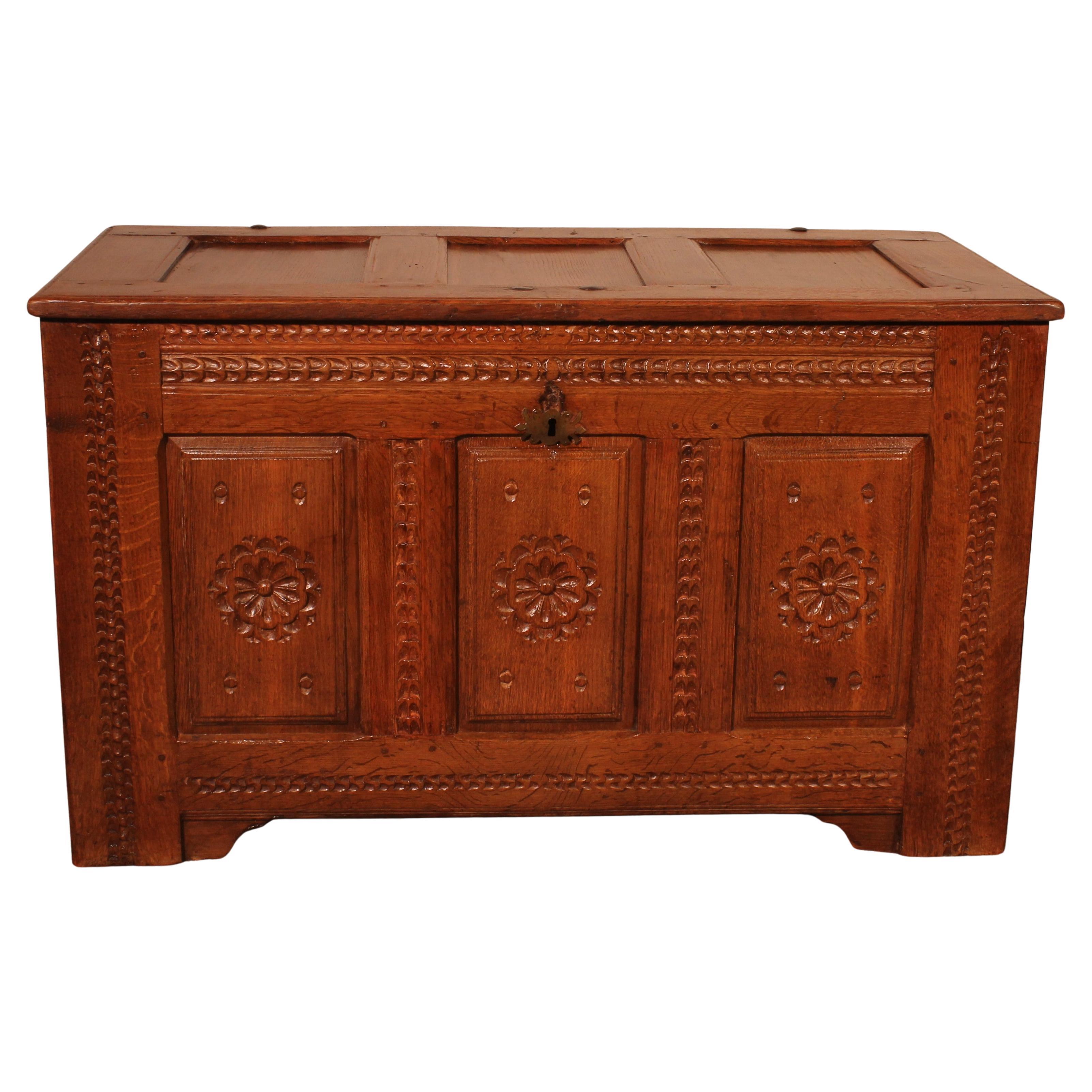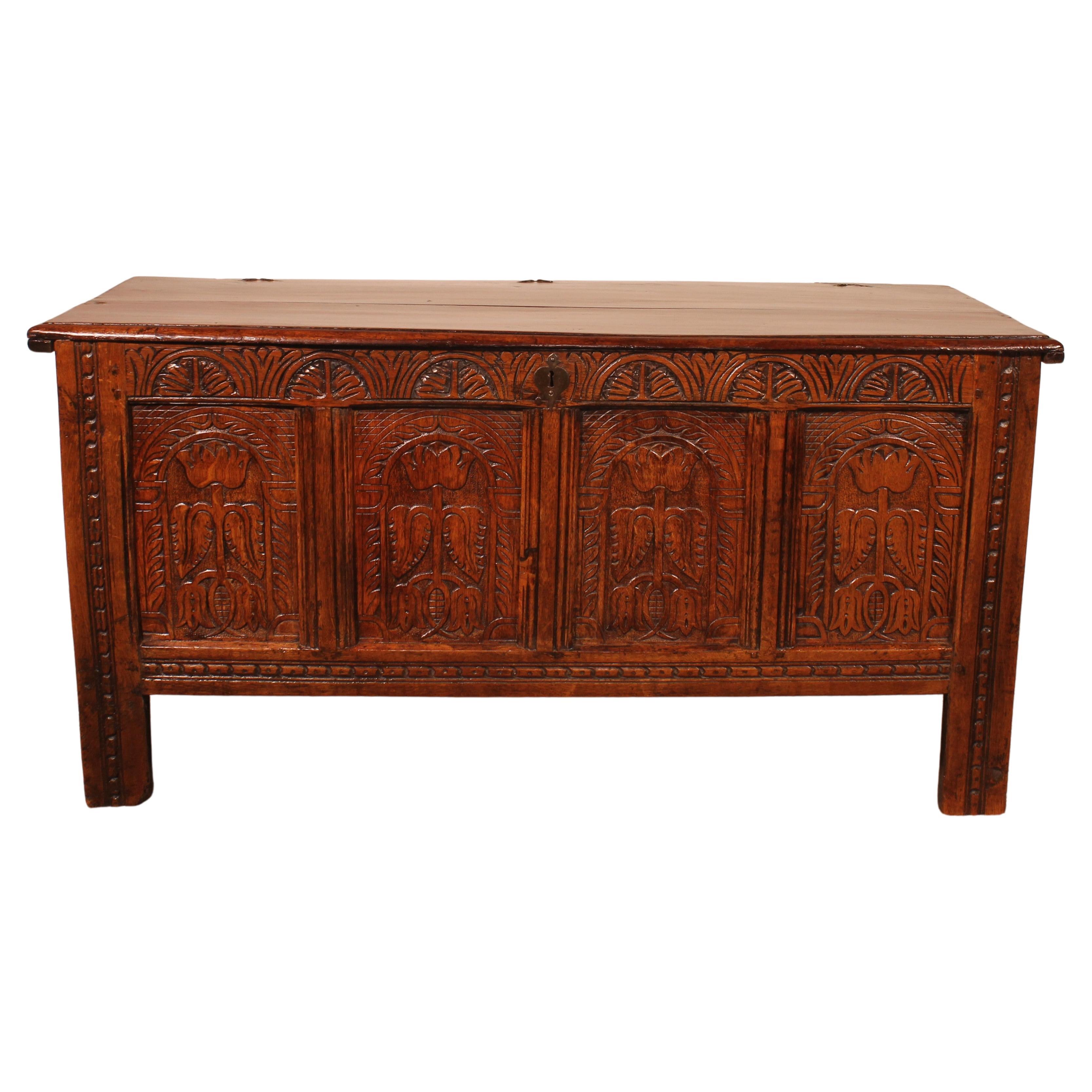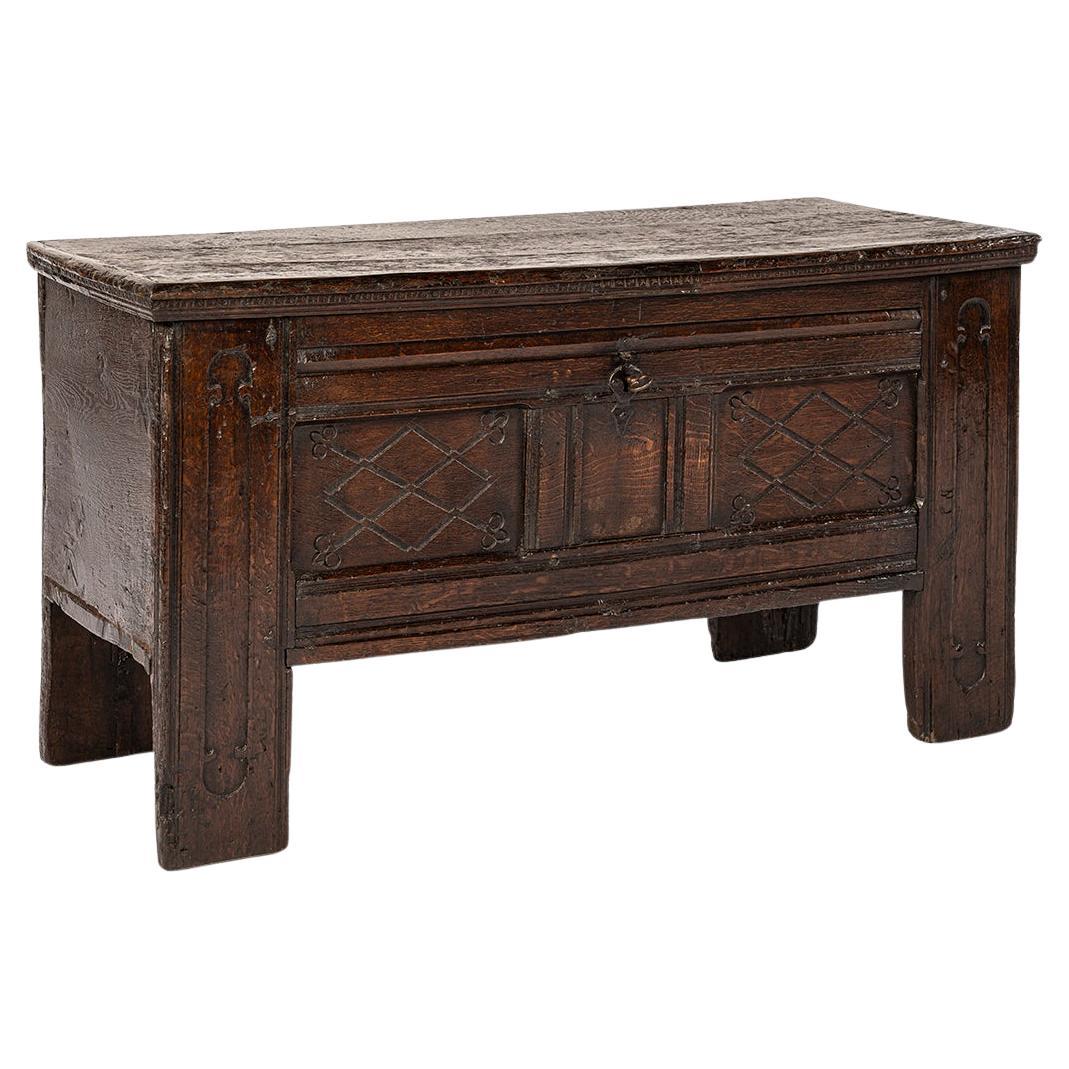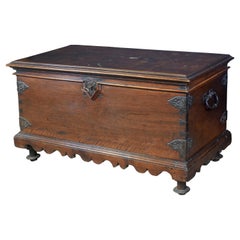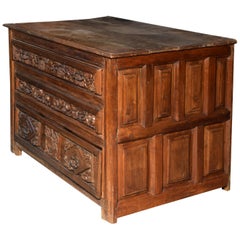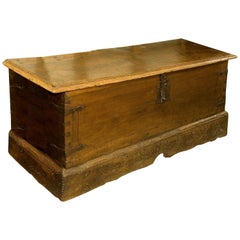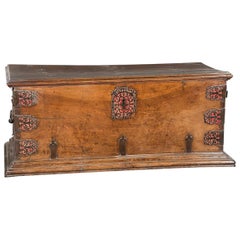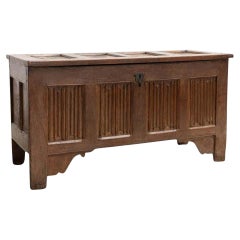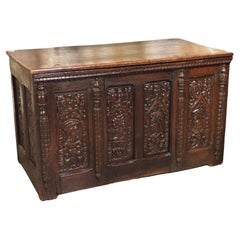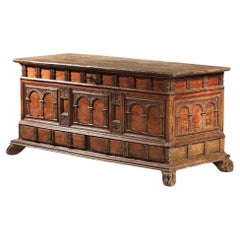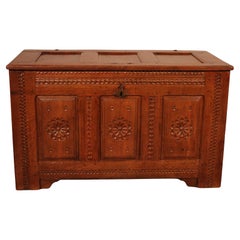Items Similar to 16th Century Gothic Chest, Pinewood, Metal
Want more images or videos?
Request additional images or videos from the seller
1 of 8
16th Century Gothic Chest, Pinewood, Metal
$5,964.56
£4,409.67
€5,000
CA$8,204.16
A$9,119.43
CHF 4,780.21
MX$111,370.32
NOK 59,678.17
SEK 56,146.02
DKK 38,064.92
About the Item
The relief of folded cloths was common in the Gothic furniture, coming from Flanders in the 15th century and used in Spain in a common way well into the 16th century, although 17th century examples are preserved that maintain this decorative element. As for wood, although walnut is common in Spanish furniture, it is not unusual to find examples carved in pine wood. Gothic arches can now be found in several prominent museums: the National Archaeological Museum of Madrid preserves four Gothic arches from the 15th century (with Gothic architectural decoration and other carved elements); the Lázaro Galdiano Museum has an Italian example of the 15th century with work of skylights and arches reminding the cloths of Muslim diamonds (Inventory 2141); the Museum of Navarre has a wedding ark of wood and embossed and polychrome leather of the last third of the 15th century (inventory CE000115); etc. The National Museum of Decorative Arts has an oak wood sideboard
(CE01616) decorated with panels "carved" or "parchment", dated circa 1500, and an ark with similar decoration dated between 1476 and 1525 (CE19287)."
Size: 189 x 62 x 90 cms.
- Dimensions:Height: 35.44 in (90 cm)Width: 74.41 in (189 cm)Depth: 24.41 in (62 cm)
- Style:Renaissance (Of the Period)
- Materials and Techniques:
- Place of Origin:
- Period:
- Date of Manufacture:16th Century
- Condition:Wear consistent with age and use. Minor losses. Minor structural damages. Minor fading.
- Seller Location:Madrid, ES
- Reference Number:Seller: ZE1481stDibs: LU2951312525681
About the Seller
4.9
Vetted Professional Seller
Every seller passes strict standards for authenticity and reliability
Established in 1985
1stDibs seller since 2017
349 sales on 1stDibs
Typical response time: 17 hours
- ShippingRetrieving quote...Shipping from: Madrid, Spain
- Return Policy
Authenticity Guarantee
In the unlikely event there’s an issue with an item’s authenticity, contact us within 1 year for a full refund. DetailsMoney-Back Guarantee
If your item is not as described, is damaged in transit, or does not arrive, contact us within 7 days for a full refund. Details24-Hour Cancellation
You have a 24-hour grace period in which to reconsider your purchase, with no questions asked.Vetted Professional Sellers
Our world-class sellers must adhere to strict standards for service and quality, maintaining the integrity of our listings.Price-Match Guarantee
If you find that a seller listed the same item for a lower price elsewhere, we’ll match it.Trusted Global Delivery
Our best-in-class carrier network provides specialized shipping options worldwide, including custom delivery.More From This Seller
View AllChest, Walnut, Textile, Wrought Iron, 17th Century
Located in Madrid, ES
The shape of this chest, rectangular with flat top, is also the usual in this type of furniture since the Gothic in the Spanish school. It is necessary to highlight the importance that the typology has on Spanish Antique furniture...
Category
Antique 17th Century Spanish Baroque Blanket Chests
Materials
Wrought Iron
Spanish chest of drawers for Sacristy-Use, Walnut, Iron, 17th Century
Located in Madrid, ES
Chest of drawers in walnut wood with carved decoration. Spain, 17th century.
Cabinet of three very deep drawers with the lower one more, on rectangular legs and with top board strai...
Category
Antique 17th Century Spanish Baroque Commodes and Chests of Drawers
Materials
Iron
Burgalesan Chest, Walnut, Iron, Spain, 17th Century
Located in Madrid, ES
17th Century Baroque Burgalesan Walnut and Iron Rectangular Spanish Blanket Chest
Rectangular chest with a flat lid made of carved walnut wood, with corners and bolts in front to loc...
Category
Antique 17th Century Spanish Baroque Blanket Chests
Materials
Iron
Walnut and Iron Chest, 17th Century
Located in Madrid, ES
Rectangular chest with base and lid with moldings and iron fittings and corners in forge metal on a red cloth background made with stylized and simplif...
Category
Antique 17th Century European Baroque Blanket Chests
Materials
Iron
Castillian Chest, Walnut, Textile, Wrought Iron, Spain, 17th Century
Located in Madrid, ES
The different pieces of ironwork follow a tradition that is already in arks at the end of the 16th century (compare the example shown with the Gothic chest from the 15th century of t...
Category
Antique 17th Century Spanish Baroque Blanket Chests
Materials
Wrought Iron
Castillian Chest, Walnut and Wrought and Polychromed Iron, Spain, 17th Century
Located in Madrid, ES
Castilian chest. Walnut wood, wrought iron andpolychrome. Spain, 17th century.
Rectangular chest with a flat top, slightly raised onspheres, decorated on the outside with smoothmol...
Category
Antique 17th Century Spanish Baroque Blanket Chests
Materials
Other, Wrought Iron
You May Also Like
Gothic 16th Century Wood Chest
Located in Barcelona, Barcelona
Gothic oak chest from 16th century with paneled lid and 4 linenfold panels in the front,
circa 1500-1530
From the low countries, (Netherlands).
In good original condition, with min...
Category
Antique 16th Century Dutch Gothic Blanket Chests
Materials
Oak
$8,308 Sale Price
30% Off
16th Century French Renaissance Chest in Carved Oak
Located in Dallas, TX
Whereas many pieces of furniture during the Italian Renaissance were heavily painted or inlaid with decorative motifs, French examples utilized hand-sculpted elements as the predomin...
Category
Antique 16th Century French Renaissance Blanket Chests
Materials
Wood, Oak
17th century Spanish or Italian carved solid wood chest
Located in Ternay, Auvergne-Rhône-Alpes
Spanish or Italian 17th century bis chest.
Chest structure in solid walnut, entirely hand-carved. Exceptional craftsmanship.
Very naive vintage conduction with a nice patina on the...
Category
Antique 17th Century Italian Gothic Blanket Chests
Materials
Walnut
Renaissance Oak Chest - 17th Century
Located in Brussels, Brussels
superb oak chest from the French Renaissance of the 17th century
Very beautiful paneled chest with a beautiful work of sculpture on its face with the sculpted uprights as well as the...
Category
Antique 17th Century European Renaissance Blanket Chests
Materials
Oak
Oak Chest From 17th Century 4 Panels
Located in Brussels, Brussels
Superb English chest from the 17th century in oak composed of 4 panels
rare chest due to its quality of sculpture which is exceptional and its 4 panels since very often 3 panels
Ver...
Category
Antique 17th Century British Jacobean Blanket Chests
Materials
Oak
Antique 16th Century German Dark Brown oak carved Stollentruhe Trunk or Chest
Located in Casteren, NL
Rare and early German Stollentruhe, dating from around 1620. This compact 17th-century oak chest combines historical significance with visual prese...
Category
Antique Early 17th Century German Renaissance Blanket Chests
Materials
Steel
More Ways To Browse
Antique Metal Cans
Gothic Antique Furniture
Antique Chest Panel
Embossed Metal Furniture
Antique Metal Panel
Wood 16th Century
16th Century Italian Furniture
16th Century Wood Furniture
16th Century Carved
Antique Metal Chest
Gothic Arch
16th Century Spanish
Chest Museum
15th Century Spanish
Antique Leather Chest
Italian Gothic Furniture
Italian Gothic
Chest Spain


